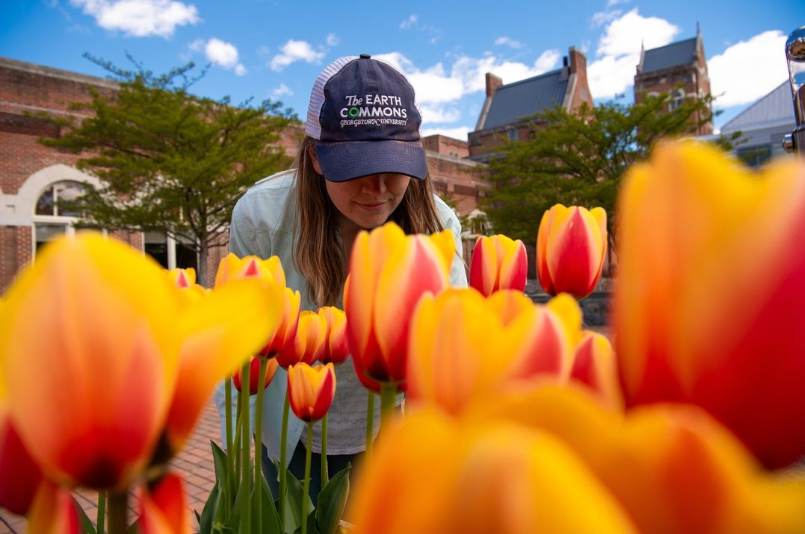The Earth Commons, Georgetown University’s hub for environmental sustainability, launched a month-long Get Outside Challenge encouraging students to spend more time outdoors in celebration of Earth Month.
The challenge, which began March 18 and concludes on Earth Day, April 22, provides participants with weekly prompts to complete outdoor activities like hiking and meditating, with the goal of improving their mental and physical health. Other Georgetown organizations have also encouraged participation in the challenge, including Outdoor Education, the Office of Sustainability, Student Health Services, Counseling and Psychiatric Services, Health Education Services, Campus Recreation, the Disability Cultural Center and Campus Ministry.
Claire Cheah (SFS ’26), a student program assistant at the Earth Commons who led the majority of planning for the Get Outside Challenge, said that, when designing the challenge, she was inspired by Nature Rx, a nationwide grassroots movement campaigning for the health benefits of spending time in nature.
“Nature Rx is actually a national program which was started in D.C. by a group of doctors,” Cheah told The Hoya. “Nature Rx partners with physicians, healthcare professionals and social service providers to prescribe spending time outside.”
Operating on the notion that spending time outdoors is not a one-size-fits-all goal, the Earth Commons offered various paths students could take for the Get Outside Challenge, including tracks for aspiring artists, naturalists, adventurers, influencers, volunteers and sages. The tracks featured different nature-based activities depending on the participant’s preferred activities.
Elizabeth Mao (CAS ’24), a guide for Outdoor Education, a university organization that sponsors wilderness-based activities, said that the wide range of possible prompts should make getting outside more interesting and feasible for a larger group of students.
“This is a great way for people to go out and explore things they might not have thought to do before, especially activities that are fairly easy to engage in and widely accessible, such as taking photos or learning more about plants on campus,” Mao told The Hoya.
Cheah said that by offering diverse ways for students to participate in the challenge, the Earth Commons hoped to compel a wide array of Georgetown students to consider developing their own unique relationship with outdoor time.
“We want to show students the benefits of getting outside, encouraging people to follow their own paths within nature,” Cheah said.
The artist path, for instance, prompts students to journal while sitting outside and engage in outdoor photography. On the other hand, students on the adventure track are challenged to visit every location on the Earth Commons’ map of green spaces in the District. Participating students submit a selfie for proof as well as a short written reflection for each completed activity, and the students with the most submissions can earn prizes such as REI discounts, Georgetown merchandise and free dinner from Chaia Tacos.
Mao said that she has seen strong student engagement with the Get Outside Challenge.
“I have some friends who have taken this opportunity to lay in the sun or attend events that they might not have known about if they hadn’t seen the Get Outside emails,” Mao said.
Spending time outdoors has also been proven to have a positive impact on health. Nature Rx reports that immersing oneself in nature is not only associated with elevated physiological well-being but improved mental health.
According to Lois Wessel (GRD ’96), an associate professor at the Georgetown University School of Nursing with expertise in community health and environmental justice, nature often proves to be a calming, healthy presence.
“Connecting with nature is good for physical health, mental health and spiritual health,” Wessel told The Hoya. “How someone interacts with nature really depends on the person, but everyone can have protection against chronic conditions like hypertension, diabetes and depression.”
Wessel said that despite the obvious advantages of getting outside, many students find themselves spending more and more time indoors, in part because the academic structure of student life is not conducive to being in nature.
“Educators do not do enough to spend time outside with students, especially since COVID and the rise of Zoom,” Wessel said. “We are so much more sedentary. People spend time outdoors, but it is not incorporated into classes.”
Mao said she hopes that in the future, classes at Georgetown will incorporate more time spent in nature to promote student well-being.
“Even just the change of environment from being in an indoor classroom to outside can help with better focus and learning,” Mao said.









